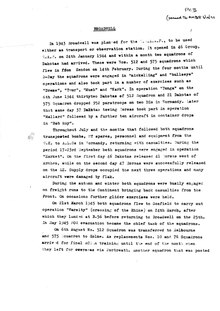RAF Broadwell

This article needs additional citations for verification. (January 2021) |
| RAF Broadwell | |||||||||||
|---|---|---|---|---|---|---|---|---|---|---|---|
| Broadwell, Oxfordshire in England | |||||||||||
| Coordinates | 51°45′25″N 1°38′22″W / 51.75694°N 1.63944°W | ||||||||||
| Site information | |||||||||||
| Owner | Air Ministry | ||||||||||
| Operator | Royal Air Force | ||||||||||
| Controlled by | RAF Transport Command | ||||||||||
| Site history | |||||||||||
| Built | 1943 | ||||||||||
| In use | 1943-1947 | ||||||||||
| Battles/wars | Second World War | ||||||||||
| Airfield information | |||||||||||
| |||||||||||
Royal Air Force Broadwell or more simply RAF Broadwell is a former Royal Air Force station located 2 miles north of Broadwell and 3 miles southeast of Burford, Oxfordshire, and within 2 miles of RAF Brize Norton.
It opened on 15 November 1943, operating under RAF Transport Command, and closed on 31 March 1947. It had three concrete runways in a triangular configuration.
History
[edit]
No. 512 Squadron and No. 575 Squadron were based here, flying the Douglas Dakota.
In February 1944, No. 512 Squadron was transferred to No. 46 Group at RAF Broadwell. It was a tactical Dakota squadron and started training glider towing and parachute dropping. Its first operation in the new role was a leaflet drop on 17 April 1944 over France; this was followed by intensive flying in and out of France, including dropping parachutists at Arnhem. In fact, 512 Squadron can claim that they were the first planes over on D Day as 3 Dakotas piloted by Fl Lt Hyde, W.O. James Proctor and a C Flight Flying Officer dropped a specialist team at 00.02 on 6 June to try and disrupt the Merville Battery before the main assault.
Broadwell took part in the D-Day assaults alongside nearby RAF Down Ampney and RAF Blakehill Farm. On the eve of D-Day, No. 575 Squadron dropped 5 Para into the invasion drop zone. On 6 June, it towed 21 Horsa gliders into France. In the next few weeks it started a casualty evacuation service from France back to England. In September 1944, it was involved in operations at Arnhem where the squadron suffered severe casualties.
The airfield continued to be a terminus for long-range transport operations to Europe, the Middle East and India.
The following units were here at some point:[1]
- No. 6 (RCAF) Casualty Air Evacuation Unit
- No. 10 Squadron RAF
- No. 21 Heavy Glider Conversion Unit RAF
- No. 76 Squadron RAF
- No. 77 Squadron RAF
- No. 91 (Forward) Staging Post
- No. 92 (Forward) Staging Post
- No. 94 (Forward) Staging Post
- No. 104 Terminal Staging Post
- No. 105 (Major) Staging Post
- No. 126 Staging Post
- No. 271 Squadron RAF
- No. 512 Squadron RAF
- No. 575 Squadron RAF
- No. 2792 Squadron RAF Regiment
- No. 2807 Squadron RAF Regiment
Current use
[edit]The site has returned to farmland and has a large solar farm covering it.[2]
References
[edit]- ^ "Broadwell". Airfields of Britain Conservation Trust. Retrieved 16 May 2020.
- ^ "Solar farm planned for WW2 airfield". BBC News. 23 April 2014. Retrieved 28 July 2020.
External links
[edit]![]() Media related to RAF Broadwell at Wikimedia Commons
Media related to RAF Broadwell at Wikimedia Commons
